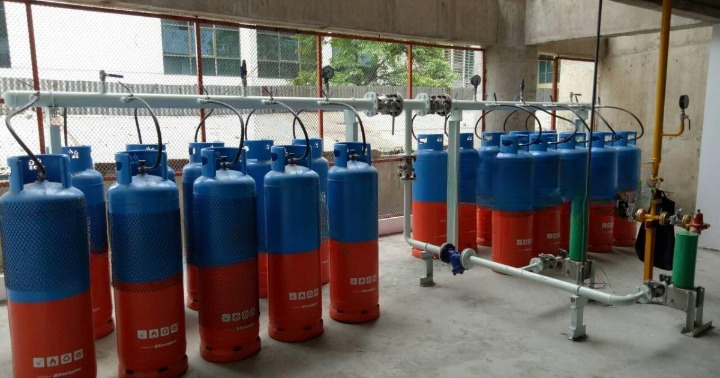Reticulated Piped Gas System
Reticulated Gas System
A reticulated piped gas system centrally distributes liquefied petroleum gas (LPG) from a bulk storage tank to multiple users, such as in residential complexes or commercial buildings. It includes a bulk storage tank, primary and secondary distribution networks, meters, regulators, and safety features like shut-off valves and gas detectors. Gas travels from the tank through the network, with meters measuring usage and regulators controlling pressure for safe appliance operation. This system provides continuous gas supply, enhances safety by reducing individual cylinder handling, and allows for efficient bulk purchasing and precise billing based on actual consumption. It is ideal for residential, commercial, and industrial applications.

SILENT FEATURES OF OUR RETICULATED PIPED GAS SYSTEM
We provides futuristic gas systems provides a robust 3 stage, pressure regulation system design i.e. PRS-I, PRS-II, PRS-III, using combination of Under Pressure Shut Off, Over Pressure Shut Off, Relief Valves, Non-Return Valves and check valve (multiple safety features)to regulate the pressure at cylinder bank from 6 bars to a low pressure of 28 milli-bars, at individual customers kitchen, or other gas run appliances such as water heaters, industrial dyers, boilers, LPG refrigerators.
Isolation valves are installed, at every riser pipeline – which rises to connect individual kitchens in the complex.
Two cylinder banks are provided with one working (active) and one standby, when the active bank is empty, the system automatically switches over to the stand-by cylinder bank (auto change over valves) thus ensuring uninterrupted gas supply to customers kitchen. The empty cylinder bank is replenished immediately.
For large number of connections, storage system (bullet) or lot (liquid off take) design is recommended. The choice is left to the discretion of the customer.
The pipelines are developed using latest piping design and network analysis software to maintain a constantly regulated low pressure flow in the client’s kitchen or other point of usage.
The cylinder manifold, pipes, pipe joints & pigtails are tested to withstand a pressure of 25kg/cm or prescribed pressure by IS6044 Part I, so that it can handle direct cylinder pressure of 4 -5 bars (almost 4 – factor of safety design).
The pipe, pigtails, pipe fittings, pressure regulating valves, check valves, non-return valves, relief valves and fittings used by us are according to specified standards and are approved by Beuro Of Indian Standards for LPG installation & Oil Company Non return valves are mounted, at every flexible pigtail and manifold, to block the main pipeline from leakage in case any of the pigtails are damaged or are ruptured.
Robust design to eradicate leakage and assure complete safety of clients. The auto changeover cum PRS-I reduces cylinder pressure from 6 bars to 1 bar. LPG flows a short length via the header to PRS-II. PRS-II is installed, near the building structure, wherein the pressure is further reduced from 1 bar to 110 mill bars and this low pressure liquid gas enters the riser pipe – the (vertical) feeder pipe, entering the consumer’s kitchen. Thus, in this full length of feeder pipe, the pressure is maintained around 110 milli-bars.
We have designed the respective system as per described norms from Bureau of Indian Standards
for LPG installation in Residential, Commercial & Industrial work.
